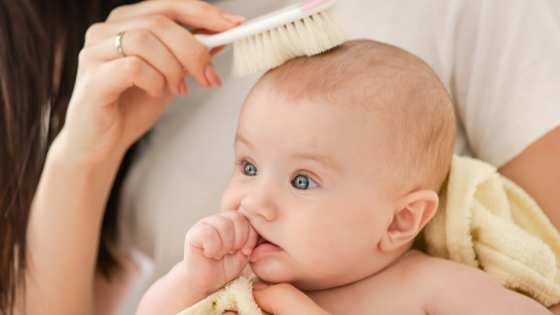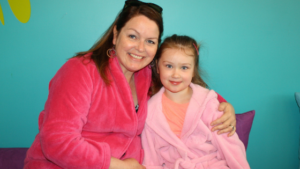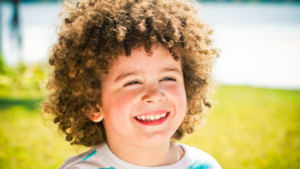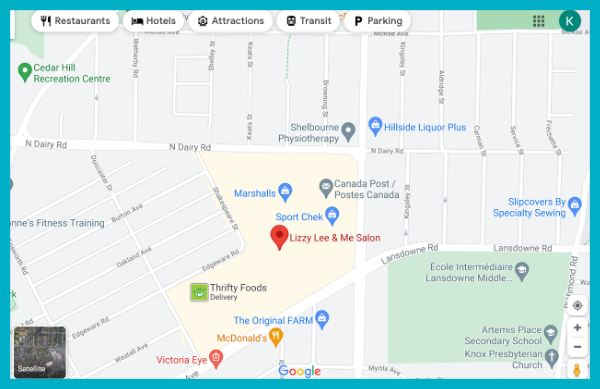
Caring for young children is not easy, especially in the earliest days when an infant’s health is closely monitored. Unexpected changes in an infant’s health during their first year are often startling to new parents. For instance, cradle cap, a skin condition affecting the scalp and skin of infants and young children, can be alarming to parents because of its thick, scaly appearance.
However, cradle cap is a common, relatively harmless skin condition that affects approximately ten percent of babies at some point in their first year of life. After being diagnosed by a healthcare professional to confirm it isn’t something else, it can be safely and easily treated at home.
Let’s look at what cradle cap is and how parents can treat the condition safely and efficiently.
What is Cradle Cap?
Cradle cap, often called “baby dandruff,” is a skin condition named seborrheic dermatitis. It occurs mainly on an infant’s scalp. It can occur in other areas of the body, such as in the diaper area, underarms and even behind the ears and knees.
It has a white or yellow appearance and typically occurs as scaly patches in the affected areas. Its flakes and crusts come away from the body, similar to dandruff, but they are thicker and larger. These flakes tend to have an oily texture.
What Causes Cradle Cap?
The cause of cradle cap is largely unknown. In infants, it’s primarily believed to be from an excess of hormones transferred by the mother while in the womb. This is largely supported because older children entering adolescence can also experience bouts of cradle cap.
Other theories suggest it’s related to the type of yeast known to cause dandruff called Malassezia yeast.
Is cradle cap harmful to my baby?
No. Cradle cap may look uncomfortable and unattractive, but it is generally harmless. Unlike other skin conditions common to infants, such as infantile eczema, this common condition isn’t itchy and doesn’t cause irritation. It is simply a build-up of skin cells that need some help to be removed from the body.
However, for cases of cradle cap that linger for several months or years, it’s best to consult your healthcare provider for additional information and support.
If your infant’s skin appears red, irritated or inflamed, the condition may not be cradle cap. In that case, consult your healthcare provider for an appropriate diagnosis and correct course of treatment.
Types of Cradle Cap Treatment
Parents use a few treatments to ease the appearance and build-up of cradle cap on their infant’s scalp and body. We’ve listed three that we find parents prefer and know are safe for a baby’s delicate skin and body. Feel free to employ multiple methods as you see fit. If your infant’s skin begins to appear red or irritated, stop the treatments and consult your healthcare provider.
1.Brush Baby’s Scalp and Hair
Gently brush affected areas using a soft, non-irritating brush. There are wonderful brushes designed to gently treat cradle cap. They can reduce flaking associated with the condition as well as combat crusting that often occurs.
Daily brushing of affected areas using a cradle cap brush or comb is recommended for best results. When brushing your baby’s scalp with a soft brush for treatment of cradle cap, try the following:
- Move the brush slowly in one direction. This will help loosen flakes.
- Continue brushing through the hair and guide loose flakes towards the tips of the hair to remove by hand.
- To help loosen the flakes, rub a gentle, natural oil into the skin before brushing.
2.Hydrate and Moisturize Baby’s Skin
Moisturize affected areas to help combat the appearance of cradle cap. Mineral oil, organic baby oil, and non-toxic moisturizers are great for fortifying your infant’s skin with the moisture it needs.
When hydrating a baby’s skin, rub a generous amount of moisturizer onto the top of your baby’s head and gently massage it all over. Allow the product to soak in and hydrate the affected areas.
Note: Do not use essential oils to treat a baby’s skin unless approved by your family doctor.
3.Use Shampoo on Cradle Cap
Mild baby shampoos and hair care products designed to treat cradle cap are great options for parents looking for a safe and natural solution to treat their infant’s skin. Look for non-toxic, chemical-free shampoos made with ingredients that are both safe and occur naturally.
Regular use of a cradle cap shampoo in conjunction with other treatment methods, such as gentle brushing and moisturizing, is ideal for controlling an infant’s cradle cap.
Cradle Cap Support is Available at Lizzy Lee & Me
Our salon is dedicated to providing exceptional hair care services to infants and young children. We have a full line of cradle cap treatment products that are gentle and safe for use on the most delicate of skin. Visit our store at Hillside Shopping Centre or our online store for more information on product availability.
Share this article
Quick Links
- Shop products
- Salon services
- Spa services
- Ear piercings
- Birthday parties
- Spa & Salon packages
Subscribe to our Newsletter
Sign up to receive our new content, product announcements, and more!





